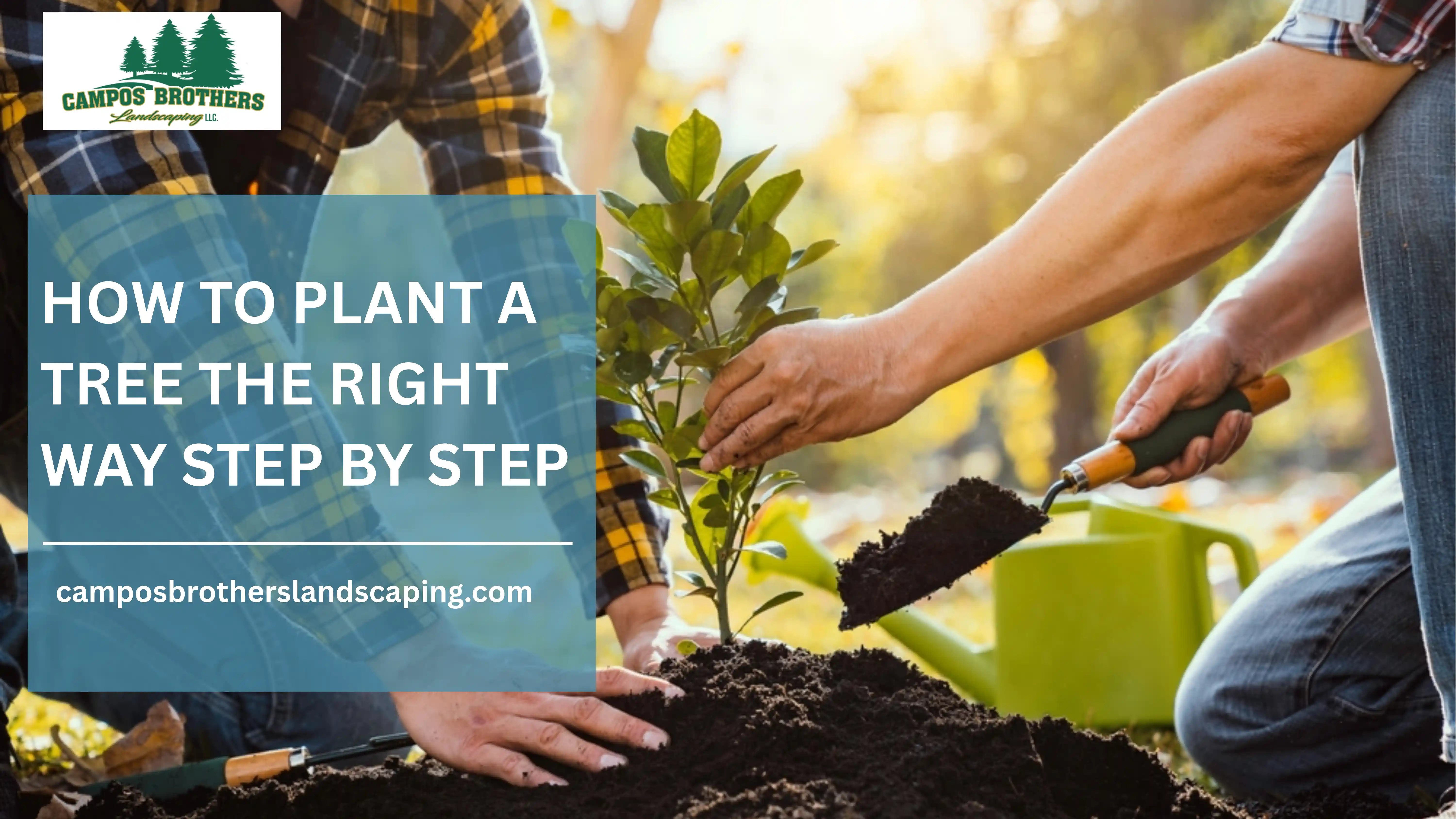How to Plant a Tree the Right Way Step by Step

Planting the best tree is more than a weekend project; it is a decades-long commitment to the landscape. A successful planting results in a healthy, mature trees that adds value, shade, and life to a property at the planting site. However, success is not a given. It depends on a series of deliberate, well-informed choices and actions, from analyzing the soil to the specific way the sapling is placed in the ground.
For property owners who want to get this foundational process right, the technical proficiency of a service like Campos Brothers Landscaping provides a clear path to a lasting and positive outcome.
How to Plant a Tree: Preparing the Right Site and Soil
The long-term health of a tree is decided before you even buy one. A thorough site assessment prevents future problems.
Mapping Sunlight and Water Flow
Spend a day observing your property. Note which areas get a full six or more hours of direct sun, which get partial sun (four to six hours), and which are mostly in shade. Most fruit trees, for instance, need full sun to be productive. Also, look for how water behaves. Does it pool in certain areas after rain? Those low, boggy spots will cause root rot in most species and should be avoided. An ideal location has good sun exposure for the chosen species and allows excess water to drain away.
How to Plant a Tree : Understanding Your Soil
You don’t need a laboratory to get a good sense of your soil. A simple percolation test reveals its drainage capacity. Dig a hole about one foot deep, fill it with water, and let it drain. Then, fill it again and track how far the water level drops in one hour. A drop of one to two inches is ideal. Much faster, and you have sandy soil that will require more frequent watering. Much slower, and you have heavy clay that can hold too much water and suffocate roots. Knowing this helps you choose a tree that can handle your specific soil conditions.
Planning for Mature Size
That small sapling will grow. Before choosing a spot, find out the mature height and canopy spread of the species you're considering. A large oak needs to be planted at least 20-25 feet from a house foundation or driveway to prevent future damage from its powerful tree roots. Also, look up. Is the space clear of overhead utility lines? Finally, before any digging, call 811. This national service coordinates with local utility companies to mark the location of underground lines on your property for free. It’s a simple call that prevents dangerous and costly accidents.
How to Plant a Tree: Choosing the Right Tree for Your Space
With a location chosen, the next step is picking the tree itself.
Hardiness Zone and Native Selections
The first checkpoint is the USDA Plant Hardiness Zone. This map tells you the coldest average winter temperatures for your area. A tree must be rated for your zone or a colder one to survive. Beyond that, consider trees native to your region. Native species are already adapted to the local climate and soil, often requiring less water and resisting local pests and diseases more effectively.
How to Plant Apple Trees: Match the Right Variety to Your Goals
Your reason for planting a tree influences the choice. If you want to learn how to plant apple trees, remember that most varieties are not self-pollinating. They require a different variety of apple or crabapple tree planted within 50 feet to produce fruit. Conversely, if you want to learn how to plant a peach tree, most are self-fertile, but you still need to select a variety with "chill hour" requirements that match your winter climate. The best place to plant a berry tree, like a serviceberry, is in an open, sunny spot with good air movement to keep the foliage dry and reduce fungal issues.
Best Time To Plant A Tree : A Step-by-Step Method
Proper technique during the planting stage is non-negotiable.
When To Plant Trees? Timing is Everything
The best time to plant a tree is during its dormancy in autumn or early spring. Planting a tree during these cooler seasons provides a great time for its root system weeks or months to acclimate and grow before the heat and stress of summer arrive. Knowing when to plant trees is a simple way to dramatically increase their odds of survival.
How To Plant Trees : Digging the Right Hole
The single biggest mistake in learning how to plant a tree is digging a hole that’s shaped like a bucket—deep and narrow. The correct method is to dig a wide, saucer-shaped hole two to three times the width of the root ball wrapped in burlap, using a spade, but no deeper than the root ball itself. This allows the roots to spread horizontally into the surrounding soil, which is essential for stability and nutrient uptake.
How to Plant a Tree: Setting It Right for Long-Term Growth
Carefully remove the tree from its container. If the roots are a thick, circling mass, make a few vertical cuts with a knife and gently loosen them. When placing the tree in the hole, identify the root flare—the area at the base of the trunk where it starts to widen out into the roots and the root collar. This flare must be visible and sit slightly above the surrounding ground level soil. Burying the root flare is a common cause of trees failure years later. Backfill the hole with only the soil you originally removed. Don't add amendments or fertilizer into the hole, as this discourages roots from growing beyond the "amended" area.
Aftercare: The First Two Years
A trees is most vulnerable during its first couple of years in the ground.
How to Care for a Money Tree Plant: Watering and Mulching Tips
New trees need consistent water as part of proper trees care. A good rule is about 10 gallons per inch of trunk diameter, applied slowly once a week during the growing season if there hasn’t been a soaking rain. After watering, apply a 2-3 inch layer of organic mulch, like wood chips, in a wide circle around the trees. Critically, do not pile mulch against the trunk; this "mulch volcano" traps moisture and invites pests and disease. Leave a few inches of space, creating a "donut" shape. This practice is universal, though the specifics of how to care for a money tree plant indoors will naturally differ, focusing more on light and humidity.
How to Plant a Tree? The Question of Staking
Most young trees do not need to be staked. In fact, the slight movement from wind helps the trunk develop strength. Only stake a trees if it’s in a very high-wind area or is too top-heavy to stand on its own. If you do, use two stakes and flexible ties that allow for some movement, and remove them after one year.
The Cost to Plant a Tree : Budgeting for Growth
The cost to plant a tree is determined by the tree's size and species, with larger, more mature trees costing more than small saplings. The price also includes labor for delivery, site preparation, and the physical planting. While a DIY approach may seem cheaper, professional installation often comes with a warranty and ensures that every step, from hole depth to root preparation, is done correctly.
What Is The Best Time Of Year To Plant A Tree?
The best time to plant a tree is during the early spring or fall. These seasons provide optimal conditions for root establishment, allowing trees to thrive. In cooler climates, planting in spring avoids frost damage, while fall planting benefits from warmer soil temperatures for healthy growth before winter.
Conclusion:
Ultimately, how to plant a tree in the ground is a precise, multi-stage project where each detail matters. It is one of the few improvements to a property that grows in value and presence over the years, offering shade, improving air quality, and creating a living landmark for generations. The considerations, from the financial aspects to the specific actions of digging and watering, are all parts of a larger commitment. Whether it's a flowering dogwood, a fruit-bearing apple, or a mighty oak, the right trees in the right place, planted with knowledge and care, becomes a lasting legacy. For a successful outcome that matures as intended, relying on the proven experience and horticultural knowledge of a dedicated team like Campos Brothers Landscaping is a direct path to achieving that vision.
